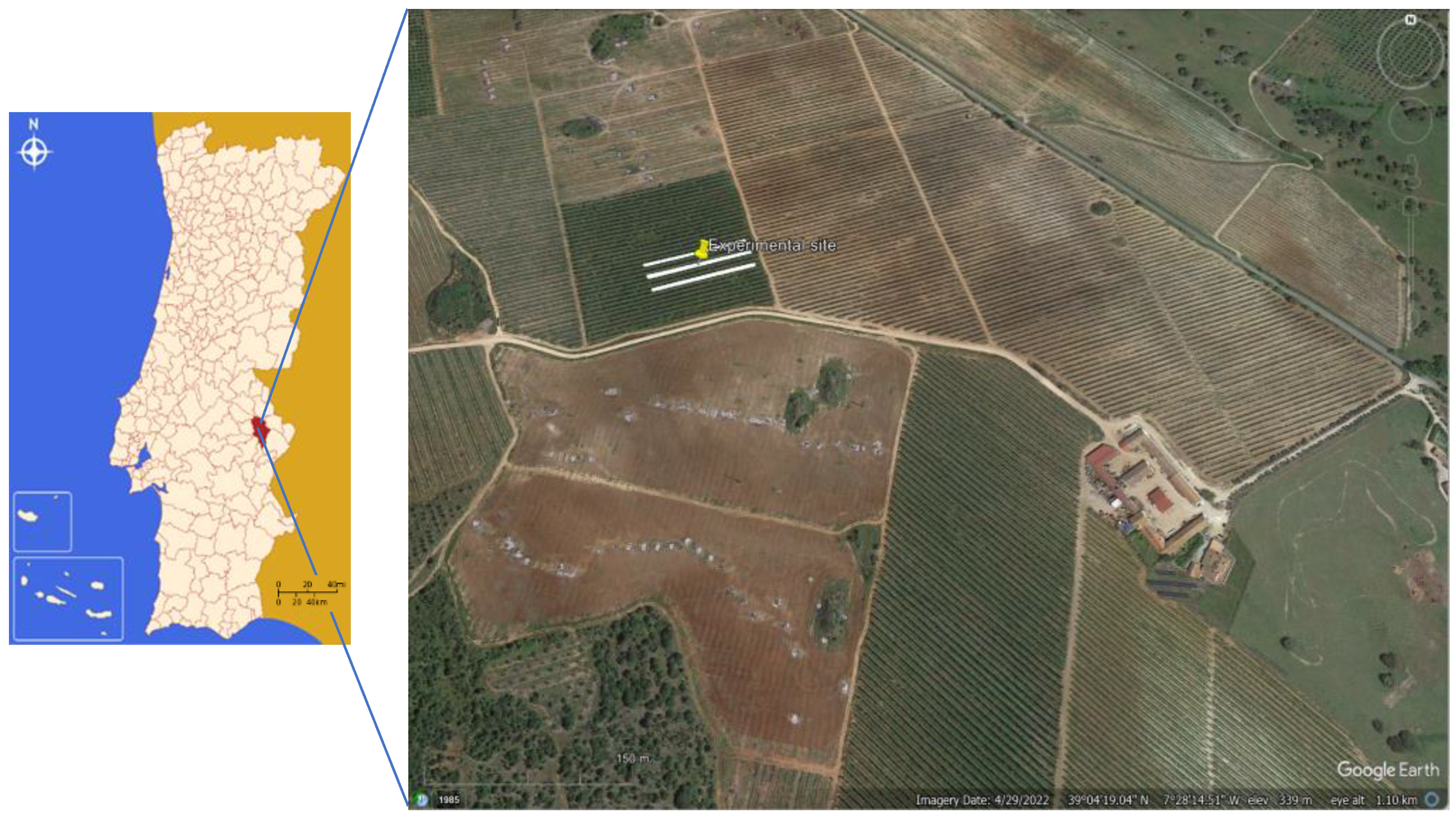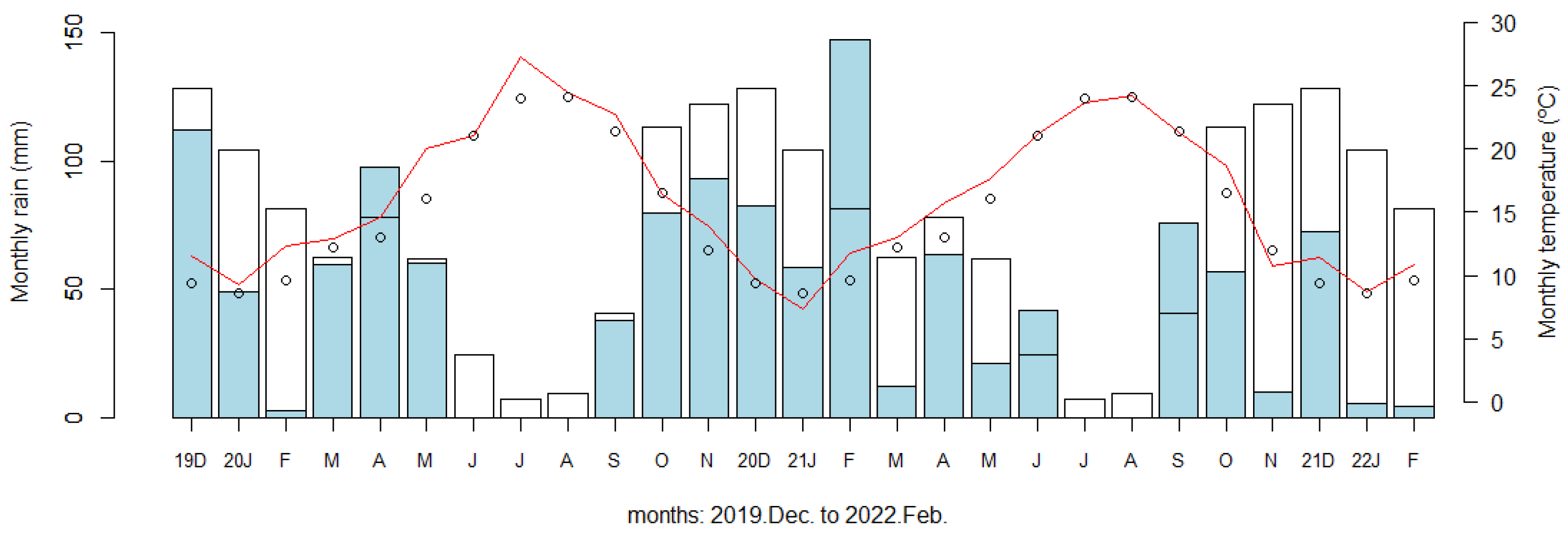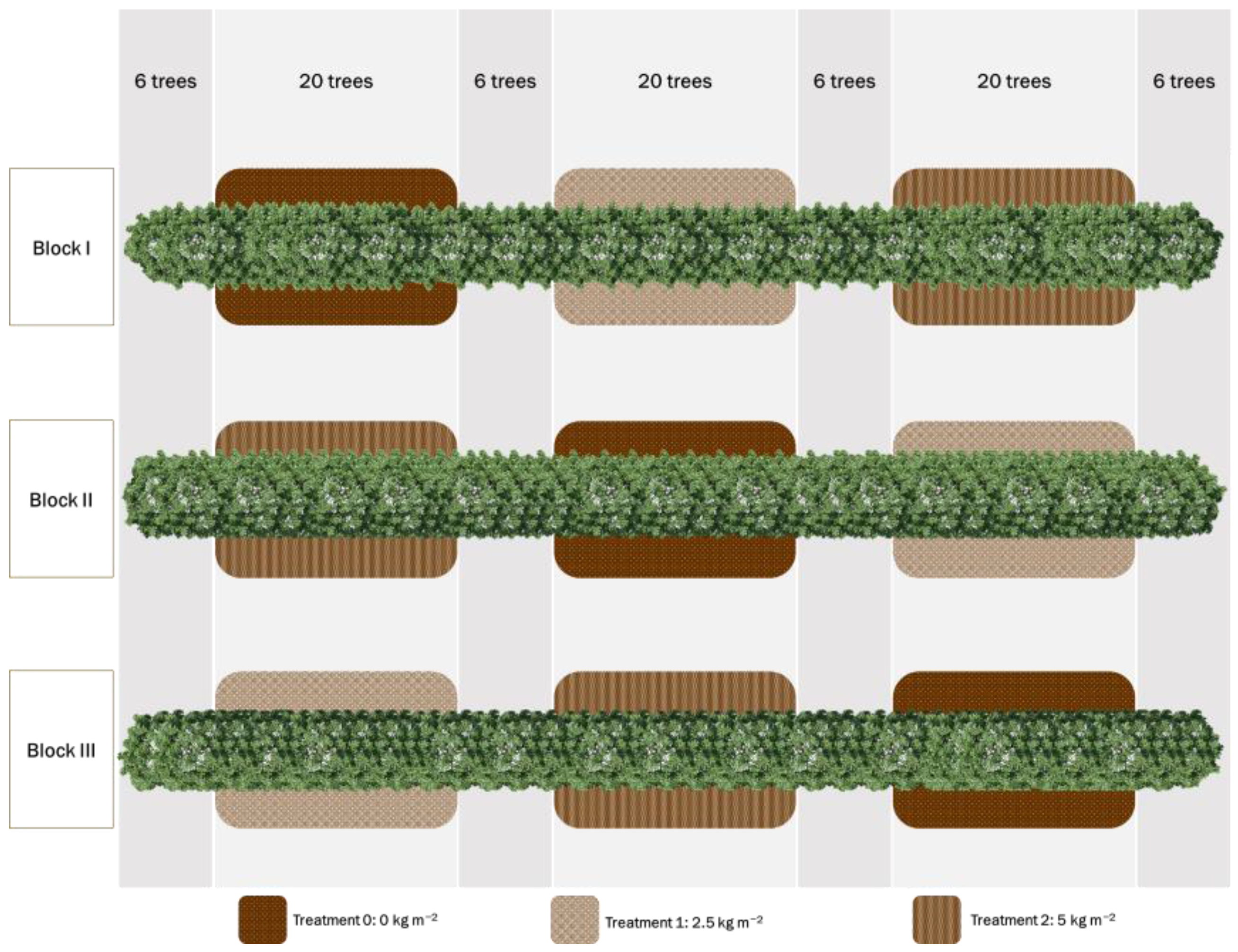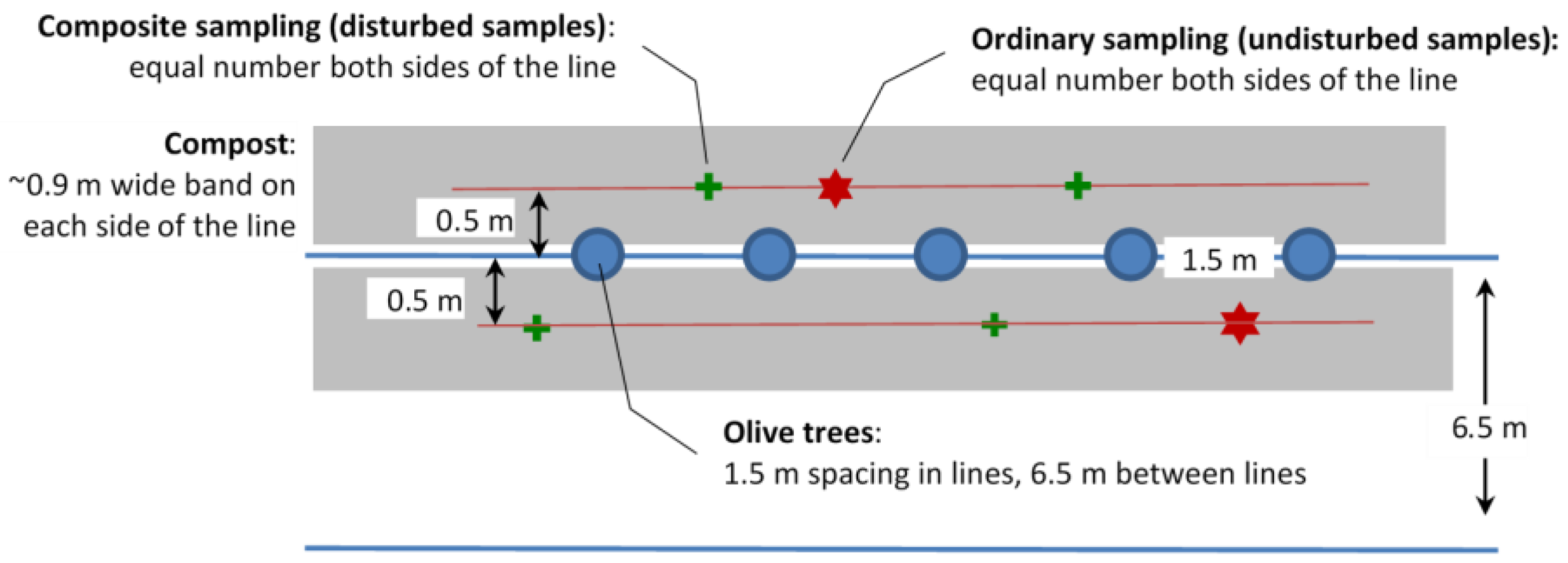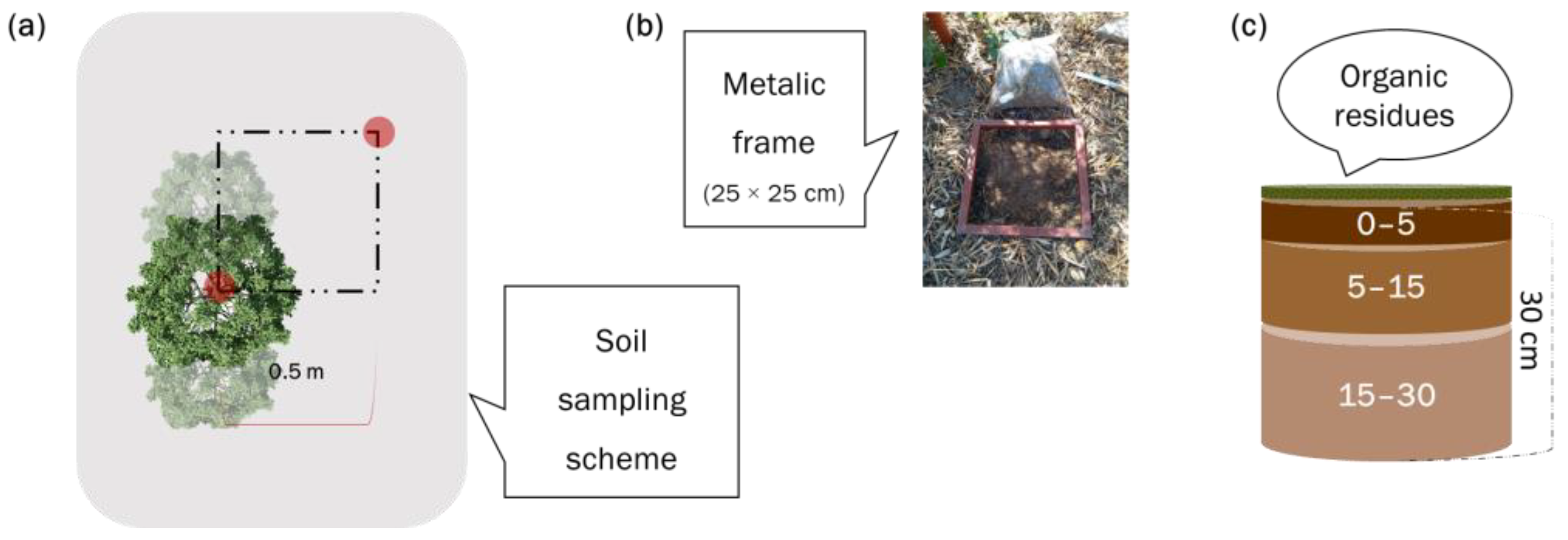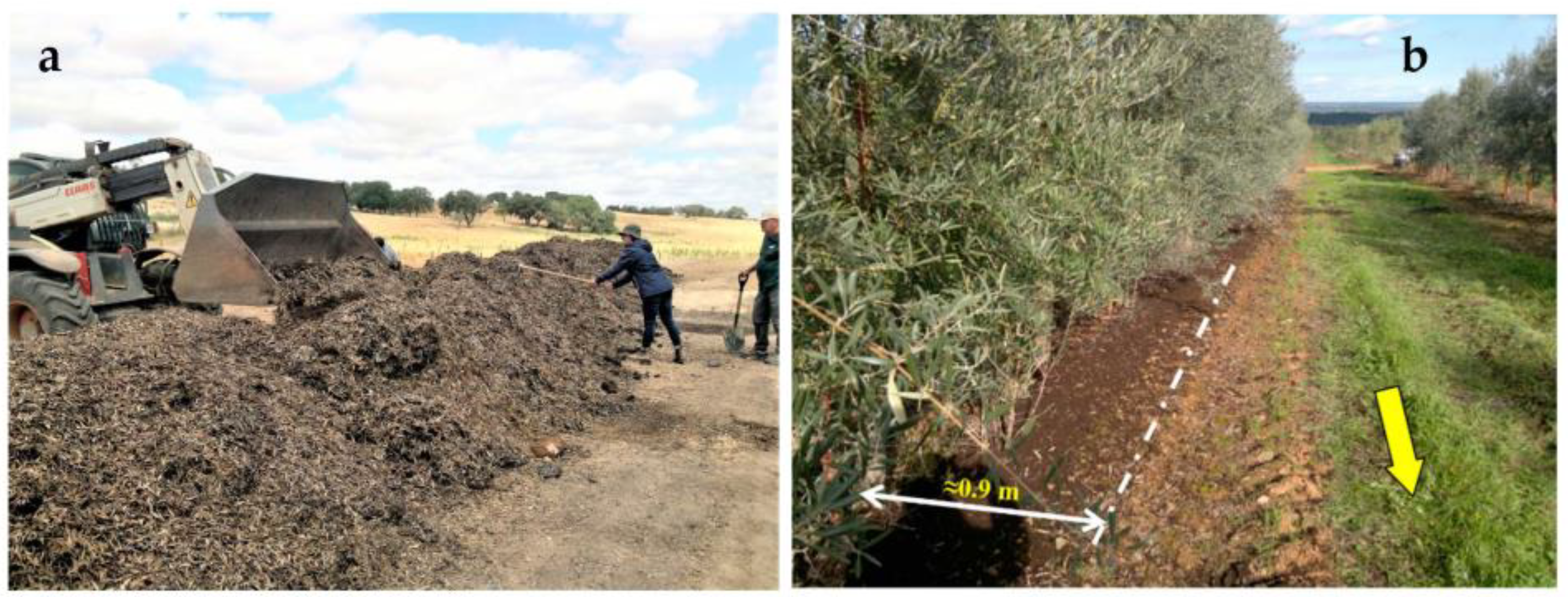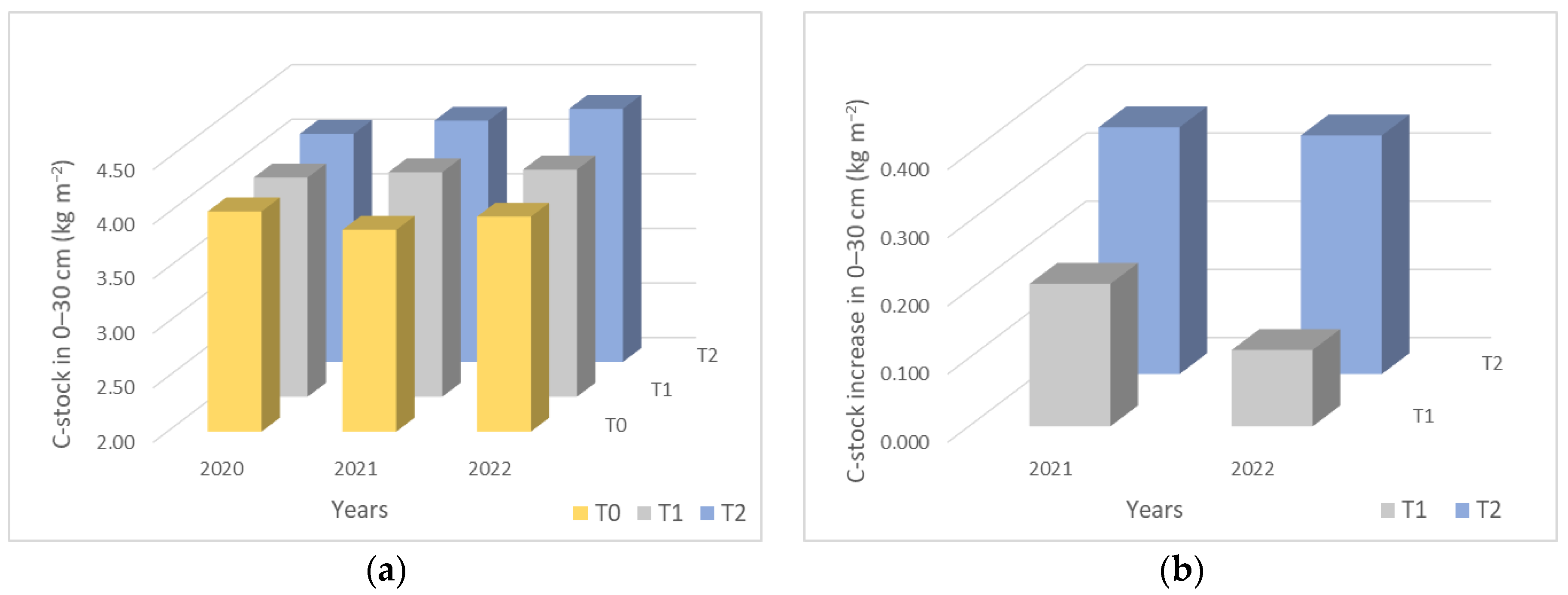1. Introduction
The composting of organic waste of agricultural origin, and its application to the soil in arable lands, is a good example of a measure of the Circular Economy integrated into the European Green Deal. Indeed, composting organic residues is a remarkable transforming process, capable of converting the problem of waste accumulation into a resourceful material with soil fertilizing and amending potential. Compost can increase the organic matter content of the soil, sequestering carbon, helping to mitigate climate change, improving various physical, chemical, and biological properties of the soil, and when integrated into crop fertilization plans, it can positively impact the economy and environment of farms by reducing the use of fertilizers and other agrochemicals [
1,
2,
3].
Despite the great expansion of olive groves in Portugal in the last 20 years and its large area of occupation in Spain (more than 0.352 M ha in Portugal and 2.5 M ha in Spain [
4]), composting with olive-generated products is not a widespread practice in both countries. Although there are some studies about the effects of the use of olive mill wastewater and/or olive mill pomace [
5,
6,
7] on soil, the literature about composting of olive leave and studies about its effect on soils are much more scarce.
Besides the natural accumulation of olive leaves at the soil’s surface due to leaf fall and pruning, huge amounts of leaves are regularly produced by cleaning olives before entering the olive mills. Theoretically, these leaves could be returned to the olive groves, for instance, by spreading them on the soil’s surface. However, this practice is very rarely (if ever) done in the region. Apparently, the benefit of adding more leaves to the soil’s surface does not compensate for the transport and spreading costs. Alternatively, these leaves can be used as bulking agents in composting mixtures to obtain a product with a higher potential for soil amending and soil C sequestration [
7]. In fact, the composition of olive leaves, namely its high C/N ratio, makes them a difficult residue to compost. Conversely, sheep and cattle manure are residues with obvious interest due to their ability to get a better mixture to compost, namely with a C/N ratio between 25 and 35 [
8]. Sheep and cattle are also common in the region, and a big sheep herd from a nearby farm provided the necessary manure for this experiment.
This study presents the results of a field trial, implemented as a complete randomized blocks design, in a hedged olive grove, with soil properties monitored at initial conditions, one year, and two years after spreading at the soil’s surface a compost of olive leaves and sheep manure (2:1). The main objectives were (i) monitoring effects on soil, especially on chemical properties, including on soil organic carbon (SOC) and some soil organic matter components, and (ii) assessing, among the methods used, which ones were able to detect short-term effects in the soil.
2. Materials and Methods
2.1. Site Characterization and Crop Management
This experimental study was undertaken near Monforte, Portalegre district, Portugal (experimental field: 39°4′9.23″ N 7°27′59.33″ W,
Figure 1). The region has a Mediterranean climate, with mild short winters and hot, dry summers (Csa climate by Köppen-Geiger). Climatological data (1981–2010) registered in the nearest meteorological station (Portalegre) shows an annual average air temperature of 15.2 °C, with monthly average temperatures varying from 8.6 °C in January to 24.1 °C in August. The annual average of precipitation in the same period was 833 mm, varying from a minimum monthly average of 7 mm in July to a maximum of 128 mm in December (
Figure 2) [
9].
During the time period of the experimental study (February 2020 to January 2022), there were some major deviations from the normal rainfall values for 1981–2010 (
Figure 2 and
Table 1). Basically, only four of 27 months (April 2020, February, June, and September 2021) registered rainfall above the normal monthly values (1981–2010). In both years of the experimental study, from February 2020 to January 2022, it was notoriously a yearly rainfall much lower than normal (833 mm): 570.4 mm from February 2020 to January 2021 and 504.3 mm from February 2021 to January 2022 [
10]. Additionally, considering the time periods between samplings, it is worth mentioning a much lower cumulative rainfall during the second year: (i) 729.3 mm from February 2020 to March 2021 (219.1 mm from February 2020 to July 2020, plus 510.2 mm from August 2020 to March 2021), and (ii) 345.4 mm from April 2021 to January 2022. Monthly averaged temperatures were persistently above normal values (1981–2010); only three months were notoriously below normal (January, July, and November of 2021,
Figure 2).
Table 1 summarizes data for quarters, showing air temperature (T) deviations from the climate normal temperature and cumulative precipitation (R) ratios with normal precipitation (1981–2010) during the time span of this study. Temperatures were quite above normal during almost the entire period. In rainy seasons, only two quarters presented rainfall around normal values (spring of 2020 and winter of 2021). All remaining quarters, starting in the spring of 2021, have been much drier, leading to the ‘severe’ drought declaration in February of 2022 [
11].
The experimental trial set up for this study is located in a gentle slope (2–5% slope gradient), approximately SW-NE oriented (
Figure 1). It was installed in 2020 in a hedgerow olive grove (
Olea europaea L., cv. ‘Cobrançosa’), six years old, which has been managed to achieve high production standards. Dominant soils are Skeletic Regosol and Vertic Luvisol, both with intermediate textures (loam to clay loam) in the superficial horizons and with the occasional occurrence of carbonates, especially in deeper layers [
12]. Scattered carbonate can appear near the soil’s surface as a result of deep soil tillage carried out previously, namely, in operations for the installation of the olive grove. Soil management adopted include drip irrigation, fractionated soil fertilization (total amount of macronutrients provided yearly: 110 kg ha
−1 N, 53 kg ha
−1 P
2O
5, and 166 kg ha
−1 K
2O, applied as solid, liquid, and foliar fertilizers), plant health control, no tillage (since 2014), weed control by mechanical means in the interrow, and by the herbicide in the row.
2.2. Experimental Layout and Soil Sampling
The experimental layout is a randomized complete block with three blocks (replicates), each one with three treatments (one replicate per block), giving a total of 9 plots (
Figure 3). Each block (I, II, and III) consisted of one line of trees divided into three consecutive plots. Each plot is formed by 20 olive trees separated from the following plot by six border trees. Two tree rows border consecutive blocks (not represented in
Figure 3). This olive grove has a tree spacing of 6.5 m × 1.5 m (6.5 m between tree rows and 1.5 m between trees in the same row), and plots have approximately 60 m
2 (30 m × 2 m, ~1 m each side of the row—see
Section 2.3). The three plots in each block were randomly allocated to one of the three nominal dosages of compost (treatments): T0 or control (0 kg m
−2), T1 (2.5 kg m
−2), and T2 (5.0 kg m
−2)—
Figure 3.
Soil sampling in each plot was carried out by randomization of the trees, both for disturbed and undisturbed soil samples (
Figure 4). Tree position was assumed as being at the vertex of a 0.5 m square, and soil samples were collected at the opposite vertex (
Figure 5a). Organic residues and undisturbed soil samples were collected from an area delimited with a 25 × 25 cm
2 metallic frame (four samples per plot, total N = 36,
Figure 5b). Considering that the compost was applied as a mulch at the soil’s surface, in order to maximize the detection of short-term soil changes, three soil layers of increasing thickness were sampled (0–5 cm, 5–15 cm, and 15–30 cm,
Figure 5c). One composite soil sample per plot and layer was collected from a minimum of 12 sampling points extracted with a hand probe equally distributed on both sides of the tree row.
The compost addition was carried out at the end of February 2020, and soil samplings were done (i) before that, at the beginning of 2020, and approximately (ii) one year (March 2021), and (iii) two years (January 2022) after the soil amendment.
2.3. Compost
The compost was produced on the farm in a four-month duration process (June to September 2019), using leaves and twigs resulting from the olives’ cleaning before entering the mill, and sheep manure with a ratio of 2:1, respectively. Previously, small amounts were used to test the composting process of mixtures with different proportions. The final proportion selected for the total amount needed (pile scale in
Figure 6a) allowed obtaining a mixture with a more favorable C/N ratio (~27) than the values of both components (C/N > 30 for olive leaves and C/N ≈ 13 for sheep manure), which would require, each of them, a longer and more complex composting process [
8,
13]. The water content and temperature of the pile were regularly controlled, adopting the ‘turned windrow method’ and using the bucket of a telescopic loader to turn and aerate the pile [
13]. After maturation, analysis of the compost revealed the following main characteristics and composition [
13]: 424 g kg
−1 of moisture, pH 8.4, 124 g kg
−1 organic C, C/N ratio of 11.8, 30 g kg
−1 CaO, 12 g kg
−1 MgO, 5.1 g kg
−1 P
2O
5, 6.1 g kg
−1 K
2O, 155 mg kg
−1 Cu, and 219 mg kg
−1 Zn.
The compost was applied in February 2020 using an adapted manure spreader (Herculano H2RSP) previously tested in order to distribute the compost at the soil’s surface in a strip of ~0.9 m width on each side of the trees’ row (
Figure 6b).
To report the applied compost dosages to larger area units, i.e., ha
−1, we must consider the effective area of application. Therefore, assuming that the compost is applied in strips of 1.8 m and 0.9 m on each side of the trees’ row (
Figure 6b), with a 6.5 m spacing, it means the area covered by the compost represents ~0.28 ha ha
−1. Therefore, the dosage 2.5 kg m
−2 (T1) corresponds to 7 Mg ha
−1, and 5.0 kg m
−2 (T2) to 14 Mg ha
−1. The same area conversion must be applied to quantitative soil effects due to the compost if they are to be reported at crop field scale. The compost dosages chosen (T1 and T2) were the result of a compromise between minimum levels to induce significant and rapid changes in the soil and maximum levels to allow the feasibility of this practice in common farms of the region.
Finally, it is worth mentioning that the compost dosages tested convey significant proportions of the total amount of macronutrients provided yearly to the olive grove in this experimental site (end of
Section 2.1). Specifically, the T1 dosage corresponds to ~48% of the N and P
2O
5 and 18% of the K
2O, and the T2 dosage corresponds to ~96% of the N and P
2O
5 and 37% of the K
2O needed on a yearly basis. However, the progressive release of nutrients depends on the mineralization rate of the compost.
2.4. Laboratory Methods and Calculations
Organic residues at the soil’s surface (amendment, when applied, and naturally occurring residues) were air dried, sieved with a 1 mm mesh sieve, oven dried at 65 °C, weighted, and expressed as a dry mass of organic residues >1 mm (kg m−2).
The bulk density of the 0–5 cm soil layer was monitored by the cylinder method [
14] in 2020, 2021, and 2022. An undisturbed soil core was collected in a 100 cm
3 metal cylinder, and the bulk density was determined by dividing the oven-dried (105 °C) mass of the soil sample by the volume of the cylinder. The bulk density of the 5–15 and 15–30 cm soil layers was determined only before the compost addition to allow soil C-stock determinations. With the compost applied to the soil’s surface, it was assumed that the bulk density of the lower layers would be kept constant during the two years period of the study.
Composite soil samples were air-dried and sieved to separate the rock fragments (>2 mm) from the soil fine fraction (<2 mm). Rock fragments were washed, oven dried at 105 °C, weighted, and expressed per total soil sample weight (g kg−1). The soil texture of the fine fraction was determined using sieving and the pipette method. Rock fragments and soil texture were determined once for soil characterization of the experimental plots.
Soil organic carbon (SOC) and total nitrogen (only sample collected in 2021) were determined by dry combustion and elemental analysis. Whenever detected, samples were previously submitted to carbonates removal following Leco’s recommended procedure.
The soil C stock is expressed as C mass for each layer and the 0–30 cm layer per area (kg m
−2). The C stock calculation took into consideration rock fragments to correct both the soil bulk density and the volume of the soil fine fraction following [
15]. The bulk density of the fine fraction,
BDff (g cm
−3), is given by:
where
MS is the dry mass of the soil sample (g),
MRF is the mass of the rock fragments in the soil sample (g),
VT is the soil sample volume (cm
3), and 2.65 is the rock fragments density (g cm
−3). Then, the
Cstock (kg m
−2) can be obtained by:
where
SOC is the soil organic carbon (g g
−1),
BDff is given by Equation (1),
z is the thickness of the soil layer (cm), and
RFm is the rock fragments as a mass of particles > 2 mm per mass of total soil (g g
−1),
BDS is the soil bulk density (g cm
−3), and 10 converts the result to kg m
−2.
Quantification of the C-stock in the layer 0–5 cm used RFm data and BDS with differentiated values for each plot. This way, we also admitted the incorporation of possible effects of the compost on the BDS and BDff, which justified more detailed monitoring of these variables in this layer, along with the SOC determination. To calculate the C-stock for layers 5–15 cm and 15–30 cm, variables RF, BDS, and BDff were averaged for the entire experimental field, assuming that they would not be significantly affected by the compost addition during the time span of the study. Therefore, the C-stock variations between treatments in the second and third layers depend only on the SOC values. The following average values were adopted, respectively, for the layers between 5–15 cm and between 15–30 cm: 108 and 91 g kg−1 for RF, 1.32 and 1.34 g cm−3 for BDS, and 1.24 and 1.28 g cm−3 for BDff.
The carbon of the particulate organic matter (POM-C) is the carbon content of the soil organic matter retained in a 0.53 mm mesh sieve [
16,
17]. As for SOC, PAM-C was determined by dry combustion and elemental analysis after carbonate removal whenever justified.
Permanganate oxidizable carbon (POX-C) was determined accordingly with the procedure of [
18,
19] and is expressed in mg kg
−1.
Both soil pHH2O and soil pHKCl were measured by potentiometry, the first one in a suspension of soil and distilled water (ratio 1:2.5) and the second one in a suspension of soil and 1N KCl solution (ratio 1:2.5).
Extractable phosphorus and potassium were determined by the Egnér-Riehm method (ammonium lactate) [
20]. Extractable micronutrient cations (Fe, Mn, Zn, Cu) were determined by the Lakanen method [
21] (ammonium acetate, acetic acid, and EDTA). All nutrients are expressed in mg kg
−1 soil (fraction < 2 mm)
2.5. Statistical Analysis
For each sampling date and each studied soil variable, the homoscedasticity of the variances was confirmed by the Fligner test, the analysis of variance was carried out, and whenever the hypothesis of equality of means had
p ≤ 0.05, the means were compared by the multiple tests of Tukey. The R software [
22] was used for all statistical analyses.
3. Results
3.1. Soil Texture of the Experimental Field
Table 2 presents soil texture data of the plots randomly allocated to each treatment (T0, T1, and T2). Although there is some variability of the soil texture among the treatments, neither the coarse fraction (rock fragments > 2 mm) nor the particle classes of the soil fine fraction (<2 mm) revealed statistically significant differences in each layer. Soil texture differences are small enough to have just two texture classes represented. Soils with T2 treatment are the most homogeneous, with all three layers being clay loam, and plots having T0 and T1 treatments are both slightly coarser, with just one clay loam layer, but located in opposite depths: in T0 is the superficial layer (0–5 cm) and in T1 is the deeper layer (15–30 cm). The maximum range of the particle classes among all plots and soil layers occurred in the 0–5 cm layer: 10.4% for sand, 4.4% for silt, and 10.7% for clay.
3.2. Organic Residues at Soil’s Surface
The mass of the organic residues bigger than 1 mm is presented in
Table 3, including one additional sampling date: July 2020, five months after the amendment application.
As could be expected, there were no significant differences between the plots allocated to the treatments before the addition of the compost (February 2020). On the contrary, five months later (July 2020), the differences are quite expressive, especially between T2 and T0 and between T2 and T1—the difference between T1 and T0, though evident, is not statistically significant.
There was a large reduction in the mass of organic residues from 2020 to 2021 in T1 and T2, though maintaining the same statistically significant differences as in the previous sampling (July 2020). From 2021 to 2022, there was only a reduction in the highest dose (T2), and no significant differences were found between treatments.
Based on the data for the T0 dosage, there was an increase of 0.49 kg m
−2 of organic residues in this five-month period. This increase in the litter layer can be mainly attributed to an occurrence of ‘olive peacock spot’ disease (
Spilocaea oleaginea), which caused the above-normal leaf fall during the spring of 2020 (local staff oral communic.). Assuming that this leaf fall was approximately uniform in all field trials, making the difference of the mean values of T1 and T2 to the T0, it gives estimates of 1.82 and 5.31 kg m
−2 of compost (dry mass) for T1 and T2, respectively. Converting the compost dry mass to fresh mass (average moisture ~225 g kg
−1), we get ~2.25 and ~6.50 kg m
−2, respectively, for T1 and T2. While the value for T1 is about 11% below the aimed nominal value (2.50 kg m
−2), for T2, the compost applied is about 30% above the nominal value (5.00 kg m
−2). It is also necessary to consider two effects that contribute to underestimating the mass of the compost by this method: (i) only residues > 1 mm were quantified, and (ii) the 5 months interval after its application, during a warmer and regularly wet spring (
Figure 1 and
Table 1), which must have contributed to some fragmentation and decay of the coarse fraction of the compost and to its consequent mass reduction. Therefore, it is admissible that while the T1 dosage should have been very close to the nominal value, the T2 should have been above the intended nominal value. In fact, there were some difficulties with the mechanical spreading of the compost, especially for the higher dosage (T2), due to aggregation and formation of big blocks. This could have led to a more heterogeneous distribution at the soil’s surface, which could explain the highest standard deviation observed in July 2020 for dosage T2 (
Table 3).
3.3. Bulk Density
The soil bulk density (
BDS) did not register significant differences between the plots allocated to the three different treatments (T0, T1, and T2), both before and one year after the compost addition (
Table 4). Only after two years (2022) a significantly lower soil density was detected in the plots where the T2 dosage was applied, compared to the T0 and T1 dosages. However, discounting the coarse fraction (>2 mm), the systematic reductions of the fine fraction bulk density (<2 mm,
BDff) observed for T1 and T2, both in 2021 and 2022, were not statistically significant.
3.4. Soil Organic Carbon and C-Stock
As shown in
Table 5, before the application of the compost (2020), the SOC mean for the plots assigned to treatments T0, T1, and T2 were not statistically different (
p < 0.05) for all layers. However, the SOC mean of the 0–5 cm layer in the plots allocated to T2 was lower than the SOC observed in plots allocated to T0, having a
p < 0.10 of both means being equal by chance.
One year after the compost spreading (2021), there were no significant differences in the SOC mean between all treatments and for all three layers. At least in part, this might be due to the high variability of the data, especially in the T2 treatment. After two years, some significant differences emerge, mainly between T2 and T0 in the layer 5–15 cm depth. But also, in the first layer, the probability of T2 and T0 having an equal SOC mean is very low (p < 0.10).
The 15–30 cm layer seems to show just random SOC fluctuations in all treatments.
Although the soil C-stock depends not only on SOC but also on the rock fragments and the bulk density of the fine fraction (<2 mm), it followed quite closely the variation pattern of the SOC. There were no significant differences one year after the soil amendment (2021). In the second year (2022), the differences were statistically significant only in the 5–15 cm depth layer, with treatment T2 having a significantly higher C-stock than T1 and T0. In spite of the higher SOC of the upper layers, the C-stock increase from the upper to the lower layer is due to the layer’s thickness increase (from 5 to 15 cm in the same sequence), which overcomes the respective SOC decrease. Adding up C-stock mean values for each layer (
Table 5), we get values for the layer between 0–30 cm, which vary from 3.85 kg m
−2 (T0, 2021) to 4.32 kg m
−2 (T2, 2022) (
Figure 7A).
3.5. Total Nitrogen and C/N
The total amount of nitrogen was determined only in soil samples collected one year after the amendment (2021,
Table 6). The total N increase in T1 and T2 dosages is clear, and it has statistical significance for the first layer (0–5 cm). In the second layer (5–15 cm), there is also a slight increase, though not statistically significant, probably due to greater data dispersion of T1 and T2 results. A small part of the total N measured is due to the nitrogen applied by the regular fertilization done in February (~12 kg ha
−1 N), approximately one month before the soil sampling (March 2021).
Data of the ratio C/N showed that the average values in T1 and T2 treatment are lower than in T0, especially in the first layer (0–5 cm), where the differences have a strong statistical meaning. However, T1 and T2 in this same layer are not statistically different. Like the first layer, the 5–15 cm layer showed a C/N decrease in the sequence T0 > T1 > T2 but without statistically significant differences between the treatments. The C/N ratio of the 15–30 cm layer did not seem to be affected by the presence of the compost.
Analysis of the compost revealed a C/N (11.8) about 2 units lower than observed in the 0–5 cm layer of the soil. This difference would not easily explain the C/N decrease in the upper soil layers receiving organic amendment. We hypothesize that this C/N reduction is also due to the regular nitrogen fertilization of the olive grove, which could have induced higher microbiological activity and higher retention of nitrogen in the upper soil layers.
3.6. POM-C and POX-C
Before the soil amendment (2020), both the POM-C and the POX-C did not show significant differences between the plots allocated to the three levels of compost dosage in all sampled soil layers (
Table 7).
One year later (2021), differences in POM-C were very expressive in the first two layers (0–5 and 5–15 cm), both showing the same sequence of values (T0 < T1 < T2) with T1 and T2 showing statistically significant differences to T0, but not among themselves. These differences were attenuated in 2022 and, though meaningful, did not have statistical significance.
POM has intermediate dimensions (>0.53 mm) and is considered to represent an initial stage of potential C sequestration in soils [
16].
POX-C showed similar behavior to POM-C in regard to treatments T0 and T2. However, the T1 treatment, though having intermediate values between T0 and T2, in all layers, neither in 2021 nor in 2022 those values distinct enough from T0 to have a statistically significant difference. On the other hand, the effect of the compost on the soil POX-C extended to the 15–30 cm layer in 2021 and to the 5–15 cm layer in 2022.
3.7. pHH2O and pHKCl
The soil pH
H2O did not show any significant difference between the treatments, even two years after the soil amendment (
Table 8). Only the pH
KCl showed a statistically significantly higher value with both compost dosages (T1 and T2) in the 0–5 cm layer after two years (2022). In addition to this, pH
KCl results revealed, more clearly than pH
H2O, an inversion of the sequence with depth, from the 0–5 cm layer to the 15–30 cm layer, both one and two years after the compost addition and especially with the T2 treatment. While in 2020, the pH
KCl was higher (or approximately constant) in the lower layers, in 2021, and even more in 2022, there was an evident decrease of pH
KCl from the 0–5 cm layer to the 15–30 cm layer.
3.8. Macronutrients Phosphorus and Potassium
Macronutrients P and K showed a contrasting pattern (
Table 9). While K did not reveal any statistically significant difference between treatments up to 30 cm depth; neither one year (2021) nor two years (2022) after the compost spreading; there were some significant differences of P in both years, mainly in the most superficial layer (0–5 cm).
The compost tested has significant levels of phosphorus (5.1 g kg−1 P2O5) and potassium (6.1 g kg−1 K2O). The levels of phosphorous and the low mobility of this macronutrient can explain its observed increase, mainly in the upper layer, just up to 5 cm deep. On the other hand, the main reason why the similar levels of potassium provided by the compost do not stand out so much as the phosphorous could be due to the high levels of potassium fertilization regularly applied in this olive grove, which is three times the level of phosphorous fertilization (53 kg ha−1 P2O5 to 166 kg ha−1 K2O, per year, personal communic.). The higher levels of potassium observed in 2021 can be explained by the soil sampling date (March 2021), which was after the main fertilization done in February. During the time span of this experimental study, almost 50% of the potassium was applied as solid fertilizer, always in February. Additionally, high rainfall in February 2021 should have contributed to enhancing the dissolution of the potassium chloride and also to leaching some potassium from the soil’s surface to the 5–15 cm soil layer.
3.9. Micronutrients Cations (Fe, Mn, Cu, and Zn)
As for micronutrients, only soil samples collected one year (2021) and two years (2022) after compost addition were analyzed (
Table 10 and
Table 11).
Extractable Fe does not register significant changes in any of the three layers in either of the two years monitored (
Table 10).
Mn tends to decrease with the compost addition, but only moderately significant differences (
p < 0.10) were observed two years after the application (2022), up to 15 cm deep (
Table 10). This slight decrease in extractable Mn in the upper soil layers can reflect the lower Mn solubility due to the pH
H2O and pH
KCl increase in these layers (
Table 8).
Extractable Cu and Zn both increased with the compost treatments, but there are some differences among them (
Table 11). While Cu increase was more evident only two years after the compost application (2022) and was just moderately significant in the first two layers (
p < 0.10), Zn was the most affected micronutrient, showing significant increases with both compost dosages (T1 and T2) and in both years. Despite the strong signals given by the Zn, especially after the first year, great variability of values occurred in the 5–15 cm layer which prevented the statistical significance of the differences observed in this layer. Additionally, the extractable Zn was substantially reduced in the second year, but the differences between T2 and T0 showed statistical significance up to 15 cm depth.
4. Discussion
Soil organic matter has a soil bulk density-reducing effect that is well known. This is a direct result of the lower density of the organic matter itself but also a consequence of the higher stability of the soil aggregates and of its complementary pore network, namely the pores created by the biological activity, usually enhanced by higher levels of organic matter. However, these effects take time and even more with the applied organic material concentrated at the soil’s surface as a mulch. Therefore, in the soils and environmental conditions of this study, it seems two years may be an insufficient lapse of time to generate unequivocally bulk density changes.
SOC and total N significant increase are common effects on soils as a result of the application of different composts [
2,
5,
7]. The results obtained in this study are aligned with that trend. However, the high variability of the SOC in the first year (2021), especially in the first two layers, has prevented statistically significant differences between the treatments. This can also be a consequence of the spreading at the soil’s surface when compared to the alternative solution of incorporating the organic amendment in a superficial soil layer. It is worth emphasizing that the results of the previously mentioned studies were obtained after three, five, or more years. In the second year of this study, trends of increasing SOC and some statistically significant differences for T1 and T2 were already obtained. It is expected that the compost spreading at the soil’s surface, though having a slower effect on SOC content, could prevent the unavoidable SOC loss due to soil mobilization for compost incorporation.
The effect of the compost on the mean C-stock of layer 0–30 cm deep (
Figure 7B) was 0.21 and 0.36 kg m
−2 for T1 and T2 in 2021 and 0.11 and 0.35 kg m
−2 for T1 and T2 in 2022. From 2021 to 2022, T1 suffered a stronger decrease than T2 in the C-stock for no apparent reason, unless the fact that the lower C-stock increase in T1 is more affected by some data variability, not only in T1 plots but also in the T0 plots. These results recommend longer periods of time for C-stock monitoring. However, based on the C applied with the compost (~0.23 and ~0.66 kg m
−2, for T1 and T2 dosages, respectively) at the end of the second year, both treatments reveal approximately 50% of C incorporation in the soil.
POX-C is assumed to reflect management practices that promote organic matter accumulation or stabilization, being considered a useful indicator of long-term soil C sequestration [
23]. POX-C was the most sensitive indicator revealing increases up to 30 cm deep after one year. Although the POX-C should still be monitored for longer periods of time, the results obtained in the first two years seem to confirm the interest of this analytical parameter to detect the effects of agricultural practices on soil organic matter [
24].
It seems that the small variations of the soil pHH2O in the T0, i.e., the reduction from 2020 to 2021 and the subsequent increase in 2022, could reflect two main effects that occurred just in 2021: (i) the application of a slightly acidifying fertilizer (pH 5.5) in February, one month before the soil sampling (March 2021), and (ii) the high rainfall in that same month of February 2021. By contrast, in 2020 and 2022, the higher soil pHH2O could reflect opposite conditions, that is, sampling before soil fertilization and occurrence of previous dry months. The compost did not show statistically significant differences in soil pHH2O, but it seems to have caused a differentiated effect with soil depth, mainly in the higher level of application (T2). Soil pHH2O increased in the first layer (0–5 cm), probably due to the non-acid cations added by the compost (3% CaO, 1.2% MgO), and tended to decrease in the lower layers (5–15 cm and 15–30 cm), due to simultaneous acidifying effects, namely the biological mineralization of the compost, the nitrification, and translocation of organic complexes of exchangeable non-acid cations in these lower layers. Soil pHKCl revealed the same general trends as soil pHH2O but showed a statistically significant increase in T1 and T2 in the 0–5 cm layer two years after the compost application (2022).
Macro and micronutrients increase, namely in P, Cu, and Zn, concomitant with results obtained by other studies with different composts and after longer periods of time [
2,
5].
The proportionally small increase in Cu with T1 and T2 relative to the T0 can be explained by the olive leaves component. The regular use of Cu-based phytopharmaceuticals (namely copper oxy-sulfide, personal communic.) in this olive grove explains the compost’s high content of copper (155 mg kg−1 Cu) and also the relatively high level of extractable copper in the soil of the T0 plots, especially in the row, under the tree canopy.
Based on the Zn content of the compost (219 mg kg
−1), its total incorporation in the 0–5 cm soil layer would give an increase in soil Zn content of ~7 and ~20 mg kg
−1, for T1 and T2 dosages, respectively, much lower values than the ~40 mg kg
−1, and ~50 mg kg
−1 increase observed in the same treatments. It is well known that Zn solubility increases with organic complexes, especially near neutral or slightly alkaline soil pH, as in the soil of this study. Additionally, at pH 7, more stable Zn complexes are formed with humic acids of weakly humified structures [
25], which could explain the reduction of the extractable Zn observed in the second year, both by progressive Zn leaching and reduction of stable complexes, i.e., due to mineralization and evolution to more humified structures.
The results of a two-year experimental field trial with a compost of olive leaves plus sheep manure (with a ratio of 2:1) applied to the tree line in a hedgerow olive grove revealed the potential to improve soil quality and soil chemical fertility, mainly through SOC, soil C-stock, total N, and extractable phosphorus increase in the 0–5 cm layer. These are positive contributions to qualify this practice as sustainable soil management. Nevertheless, the effects of this type of compost should be monitored over longer periods of time, namely, to assess its potential to increase SOC and C-stock in the long term, but also its potential to increase the risk of accumulation of extractable zinc in the soil.
